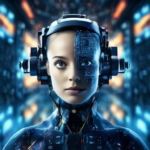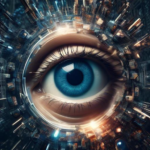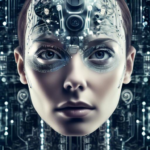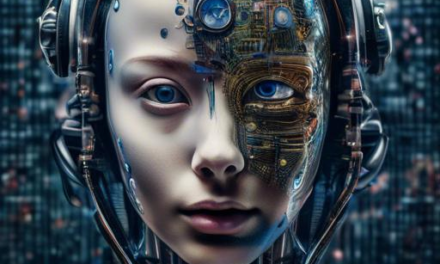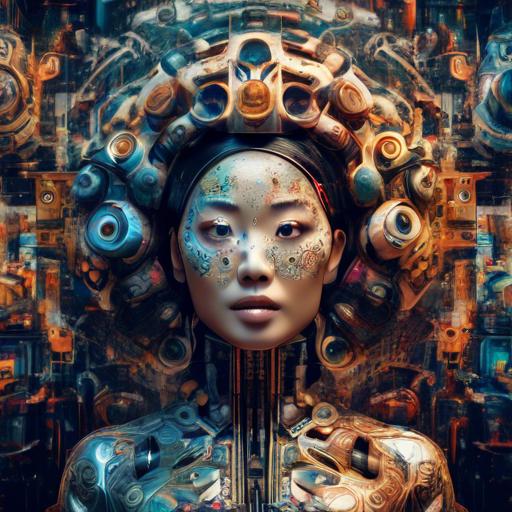In a world where pixels paint masterpieces, melodies are deciphered by algorithms, and stories come to life through lines of code, the boundaries of creativity are being wonderfully redefined. As we stand at the cusp of this exciting digital revolution, a new champion has emerged with the power to transform the landscape of intellectual property: Artificial Intelligence. With its immense potential to innovate, optimize, and even generate original content, AI is not just a tool, but a collaborator in the creative process. As we venture into this brave new world, it’s crucial to navigate the evolving terrain of copyright and intellectual property with a sense of optimism and foresight. This article aims to explore the profound impact of AI on these vital constructs, while embracing the new possibilities that lie ahead for artists and creators everywhere. Let’s embark on this journey with an open mind, recognizing the symbiotic relationship between human ingenuity and artificial intelligence, and envisioning a collaborative future where creativity knows no bounds.
Table of Contents
- Emerging Paradigms: How AI is Redefining Intellectual Property
- Navigating the Legal Labyrinth: AI and Copyright Legislation
- Creative Machines: The Intersection of AI and Artistic Expression
- Balancing Act: Protecting Human Innovation in an AI-Driven World
- Beyond Boundaries: Cross-Border Intellectual Property Challenges
- Empowering Creators: Strategies for Safeguarding Original Work
- Harnessing AI: Tools and Technologies for IP Management
- Future-Proofing: Anticipating the Evolution of Copyright and AI
- The Way Forward
Emerging Paradigms: How AI is Redefining Intellectual Property
Artificial Intelligence (AI) has made significant strides in redefining the contours of intellectual property (IP), particularly in the realm of copyright. As AI-generated content proliferates, the traditional frameworks of IP face challenges and opportunities alike. How do we navigate this brave new world where machines can create, innovate, and even infringe?
The advent of AI raises intricate questions regarding **authorship and ownership**. Traditionally, copyright law is rooted in the concept of human creation. With machines generating art, music, and literature, it disrupts the very basis of who owns the resultant works. While some argue that AI itself should be recognized as an author, others propose attributing copyright to the programmers or the users of the AI tools. Legal systems around the world are grappling with these questions, seeking to update antiquated laws to accommodate modern technological realities.
| Country | AI Copyright Policy |
|---|---|
| USA | Currently under review |
| UK | AI-created works not protected |
| Japan | Partial recognition for AI authorship |
Beyond the legal constructs, AI also influences **infringement and enforcement**. AI tools can both detect and commit copyright infringements at unprecedented scales. For example, AI algorithms capable of scanning the web can help identify unauthorized use of copyrighted materials swiftly and efficiently. Conversely, AI can also recreate protected works with subtle variations, blurring the line between inspiration and infraction.
- **Detection Tools:** AI-driven solutions can comb through large databases to identify infringements.
- **Content Creation:** AI can generate content similar to existing works, posing new challenges for IP protection.
As the paradigm continues to shift, stakeholders across industries must engage in **collaborative dialogue** to shape a fair and forward-thinking IP landscape. Artists, engineers, legal experts, and policymakers need to unite in understanding the nuances of AI’s capabilities while safeguarding creative rights. Together, we can forge a path that respects both innovation and intellectual property in this rapidly evolving digital age.
Navigating the Legal Labyrinth: AI and Copyright Legislation
In today’s digital age, artificial intelligence has woven itself into the very fabric of creative industries, spawning both innovative possibilities and intricate challenges. As AI technologies evolve, the copyright landscape becomes more complex, spurring crucial debates over intellectual property (IP) rights. These discussions primarily focus on identifying the true creator and rightful owner of AI-generated content.
Adding to the complexity is the process of training AI systems, which often rely on vast datasets of existing works. This raises critical questions about **copyright infringement** and **fair use**. Should creators of original works have the right to control how their content is used in training AI models? Furthermore, if an AI system generates a new piece of art or music, who holds the copyright: the programmer, the user, or the AI itself?
**Key Issues at the Intersection of AI and Copyright:**
- Ownership: Determining who owns the copyright to AI-generated creations.
- Licensing and Fair Use: Establishing guidelines for using copyrighted works in AI training datasets.
- Enforcement: Addressing how copyright law can be effectively enforced in the context of AI.
With governments and legislative bodies struggling to keep pace with technological advancements, different nations have started to craft their own approaches. While the **European Union** leans towards stricter regulations emphasizing copyright controls, **the United States** explores more flexible frameworks that balance innovation with intellectual property rights. Below is a brief comparison:
| Region | Approach | Focus |
|---|---|---|
| European Union | Strict Regulation | Copyright Control |
| United States | Flexible Framework | Balancing Innovation and IP |
Navigating this legal labyrinth requires a balanced approach that fosters innovation while protecting creators’ rights. Legal scholars, policymakers, and tech pioneers must collaborate in crafting laws that address the nuance and complexity of AI in the realm of intellectual property.
Creative Machines: The Intersection of AI and Artistic Expression
****
Artificial Intelligence is revolutionizing the creative landscape, but with great power comes great responsibility. As AI-generated art becomes increasingly indistinguishable from human-created works, the boundaries of copyright and intellectual property law are being tested like never before.
Consider the following scenarios:
- An AI program generates a painting that gains widespread acclaim. Who owns the copyright? The developer of the AI, the individual who input the parameters, or no one at all?
- A musician uses AI-driven software to compose a new song. Should the software be considered a co-author, and if so, how are royalties distributed?
The answers to these questions aren’t straightforward, and this has led to the rise of **complex legal debates**. Currently, copyright law is largely designed around the concept of human authorship, making its application to AI-generated works a gray area. As the laws stand, most jurisdictions do not recognize AI as capable of holding copyright ownership. This raises significant issues:
| Challenge | Impact |
|---|---|
| Authorship | Who is the true creator? |
| Ownership | Legal attribution and rights |
| Reproduction | Handling derivatives and copies |
On the creative front, AI tools open up new possibilities but also **necessitate new forms of protection**. Artists and developers must navigate a maze of intellectual property considerations to ensure that their innovative creations are safeguarded. Here are some steps that can be taken:
- Consult with intellectual property lawyers experienced with AI issues
- Clearly define roles and contributions in collaborative projects involving AI
- Stay informed about evolving laws and industry best practices
Ultimately, the intersection of AI and artistic expression brings both challenges and opportunities. By engaging in the ongoing conversation about copyright and intellectual property, we can better understand and shape the future of creative machines.
Balancing Act: Protecting Human Innovation in an AI-Driven World
In the vibrant tapestry of human innovation, the advent of artificial intelligence has introduced threads of unprecedented complexity. As AI continues to evolve, the challenge lies in safeguarding the creative rights of individuals while harnessing the transformative potential of these intelligent systems. It is crucial to strike a balance where human ingenuity and machine intelligence coexist harmoniously.
At the Heart of Innovation: Human Creativity
- AI can analyze vast amounts of data, but it lacks the nuanced understanding and emotional depth that defines human artistry.
- Creators must be assured that their unique contributions are protected against unauthorized duplication and exploitation.
- Developing robust IP frameworks that recognize and reward human creativity is essential in an AI-driven landscape.
As AI steadily becomes more adept at generating content—be it music, writing, or art—the lines delineating original human creation from machine-generated works blur. Current copyright laws were designed with human creators in mind, posing the question: How do we adapt these laws to include AI as both a tool and a potential creator?
| Aspect | Current Approach | Future Considerations |
|---|---|---|
| Authorship | Human creators | Machine-creatively assisted works |
| Ownership | Individual or corporate | Shared between human and AI entities |
| Protection | Copyright laws | Updated IP frameworks |
Enhancing Intellectual Property Rights
- Implementing dynamic IP regulations that reflect technological advancements.
- Encouraging ongoing dialogue between lawmakers, technologists, and creators.
- Ensuring that AI systems are transparent about their inputs and processes.
By fostering an environment where human innovation is not only protected but also amplified by AI advancements, we can navigate this new frontier with confidence. The creative spirit that defines us as a species can continue to thrive, enriched by the capabilities of artificial intelligence, rather than overshadowed by it.
Beyond Boundaries: Cross-Border Intellectual Property Challenges
Artificial Intelligence (AI) is revolutionizing the landscape of intellectual property, presenting unprecedented cross-border challenges. The unpredictable and autonomous nature of AI-generated content raises significant questions regarding copyright eligibility and ownership. Here, we explore the intricate web of issues AI technology brings to the fore, and what it means for international legal frameworks.
Global Discrepancies in AI Copyright Laws
- Different countries have varying rules on the eligibility of AI-generated works for copyright protection.
- In the United States, copyright laws typically require a human author, potentially leaving AI-generated content unprotected.
- Conversely, the UK allows copyright for AI-created works, with rights assigned to the developer or programmer.
Intellectual Property Ownership: The AI Conundrum
The ambiguity in defining ownership of AI creations raises questions such as:
- Who holds the copyright? – Is it the AI creator, the developer, or the end-user?
- Can AI systems themselves hold copyrights? – A complex issue as AI lacks legal personality.
- What about collaborative AI-human works? – Determining the extent of human contribution can become a murky domain.
International Enforcement and Harmonization
Enforcing copyright protections for AI-generated material across borders remains challenging:
| Country | AI Copyright Stance |
|---|---|
| USA | Requires human authorship |
| UK | Allows copyright for AI creators |
| China | In development, currently favors human creators |
Efforts to harmonize international IP laws are essential. Without a unified approach, protecting AI-generated works could lead to a labyrinthine tangle of legal conflicts and inconsistencies across jurisdictions.
Technological and Legal Synergy: The Way Forward
As AI continues to evolve, so must our legal frameworks. Stakeholders across the globe must collaborate to create adaptive, forward-thinking regulations that acknowledge:
- The significance of AI’s contributions to creativity and innovation.
- The need for clear guidelines on ownership and rights attribution.
- The urgency for international cooperation in enforcement and dispute resolution.
Such synergy between technology and law heralds the dawn of a new era where boundaries are not barriers but bridges to shared progress and protection.
Empowering Creators: Strategies for Safeguarding Original Work
In the rapidly evolving digital landscape, creators are constantly seeking ways to protect their original works from unauthorized use and infringement. The advent of artificial intelligence (AI) has brought both opportunities and challenges in this domain. To navigate these complexities, it’s crucial to employ effective strategies for safeguarding intellectual property (IP). Here are some key approaches:
- Utilize Blockchain Technology: Blockchain offers an immutable ledger for recording and verifying ownership of creative works. By registering your work on a blockchain platform, you can establish a tamper-proof record that validates your IP claims.
- Register Your Copyrights: Official registration of your work with copyright offices, ensuring it’s legally recognized. This formal procedure provides a solid ground for pursuing legal action in case of infringement.
- Leverage Digital Watermarking: Embedding digital watermarks in audio, visual, and written content can help trace unauthorized usage. This method acts as a subtle but powerful deterrent against copying and reproduction without permission.
Moreover, AI itself can be a tool for protection. Advanced AI algorithms analyze and monitor digital environments, identifying and flagging instances of potential IP violation. This proactive surveillance empowers creators to take swift actions against infringers. Here’s a quick comparison on how traditional methods stack up against AI-powered solutions:
| Method | Traditional Approach | AI-Powered Solution |
|---|---|---|
| Detection Speed | Slow and Manual | Rapid and Automated |
| Accuracy | Prone to Human Error | High Precision |
| Scalability | Limited | Extensive |
Engaging with legal advisors who specialize in IP law is also essential. They can provide tailored advice and draft agreements that clearly outline ownership and usage rights. This legal framework ensures that creators maintain full control over their works.
raising awareness about the importance of respecting intellectual property amongst your community is vital. Educate your audience about the impacts of infringement and encourage ethical consumption and sharing of creative works.
Harnessing AI: Tools and Technologies for IP Management
The advent of artificial intelligence has significantly transformed the realm of intellectual property (IP) management. Modern systems exploit the power of AI to enhance the efficiency, accuracy, and scope of IP-related activities.
**AI-Powered IP Tools**:
- Patent Search and Analytics: AI algorithms can process and analyze vast amounts of patent data to identify potential infringements, trends, and gaps in the market. Leading platforms utilize machine learning models to provide predictive analytics, substantially reducing research time.
- Automated Trademark Clearance: AI tools can swiftly search global trademark databases to ensure that new trademarks are unique, thus preventing costly legal disputes. These tools leverage natural language processing (NLP) to understand nuanced differences between trademarks.
- Content Monitoring and Enforcement: AI-driven monitoring tools can sift through billions of online content pieces to detect unauthorized use of copyrighted material. By automating this process, rights holders can promptly address infringements and demand compliance.
**AI in IP Portfolio Management**:
AI is also revolutionizing IP portfolio management by offering intelligent solutions that optimize the value and strategic alignment of IP assets. These systems enable:
- Dynamic Portfolio Valuation: Through AI, IP portfolios can be continuously assessed for value fluctuations based on market data, technological advancements, and competitive landscape.
- Strategic Patent Landscaping: AI analysis helps in identifying key patent areas that are ripe for development or licensing, enhancing decision-making processes and competitive positioning.
- Maintenance Fee Optimization: Intelligent algorithms can analyze the cost-benefit of maintaining each IP asset, helping organizations focus resources on high-value patents while shedding less critical ones.
**Comparing Traditional vs. AI-Enhanced IP Management**:
| Traditional Approach | AI-Enhanced Approach |
|---|---|
| Manual and time-consuming patent searches | Automated, high-speed patent analytics |
| Lengthy trademark clearance processes | Instantaneous global trademark searches |
| Reactive content infringement monitoring | Proactive, real-time content surveillance |
| Periodic portfolio assessment | Continuous, dynamic portfolio evaluation |
Embracing AI technologies for IP management is not just about enhancing efficiency; it’s about transforming the way intellectual property is leveraged as a strategic asset. By integrating these advanced tools, organizations can vastly improve their competitive edge and ensure robust protection of their valuable IP assets.
Future-Proofing: Anticipating the Evolution of Copyright and AI
The rapid evolution of AI technologies necessitates a fresh approach to copyright and intellectual property laws. As AI becomes more integrated into creative processes, there’s a pressing need for legal frameworks that both protect human creators and accommodate the contributions of AI-driven creativity. This balancing act calls for dynamic policies that adapt to technological advancements without stifling innovation.
- Human-Centric Protections: It’s vital to ensure that human creators are recognized and fairly compensated for their works, even when AI-assisted tools are used. Current copyright laws need to evolve to include provisions that clearly define the role of AI in creative processes and how contributions are attributed.
- AI Accountability: As AI becomes more autonomous in generating content, questions of accountability arise. Who owns a piece of art created by an AI? Should an AI itself be awarded copyright, or should ownership be assigned to the programmer, the user, or a third party?
- Licensing Models: Innovative licensing models could be implemented to accommodate AI-generated content. This may include new categories of licenses that recognize joint human-AI creations, ensuring that both parties are duly credited and financial profits are fairly distributed.
| Aspect | Current Law | Proposed Improvement |
|---|---|---|
| Ownership | Human Creator Only | Shared between Human and AI |
| Accountability | Not Defined | Clear Roles for Programmers and AI |
| Revenue Distribution | To the Human Creator | Innovative Licensing Models |
Interdisciplinary Collaboration: Future-proofing copyright and intellectual property laws for an AI-driven world will require collaboration across multiple disciplines, including law, technology, and the arts. By fostering dialogue between these fields, we can develop robust policies that support innovation while upholding creators’ rights.
Educational Initiatives: It’s equally important to launch educational initiatives to inform creators, legal professionals, and tech developers about the evolving landscape. Workshops, seminars, and online courses can play a crucial role in disseminating knowledge and equipping stakeholders with the tools they need to navigate these changes effectively.
The Way Forward
the ever-evolving landscape of artificial intelligence is undoubtedly shaping the future of copyright and intellectual property rights. While it may present new challenges and complexities, it also offers unprecedented opportunities for innovation, creativity, and collaboration. By staying informed, adapting to change, and fostering a culture of respect for creators and their work, we can harness the power of AI to protect and promote the value of intellectual property in this digital age. Together, let us embrace the transformative potential of AI while upholding the integrity of copyright and intellectual property rights for generations to come.


